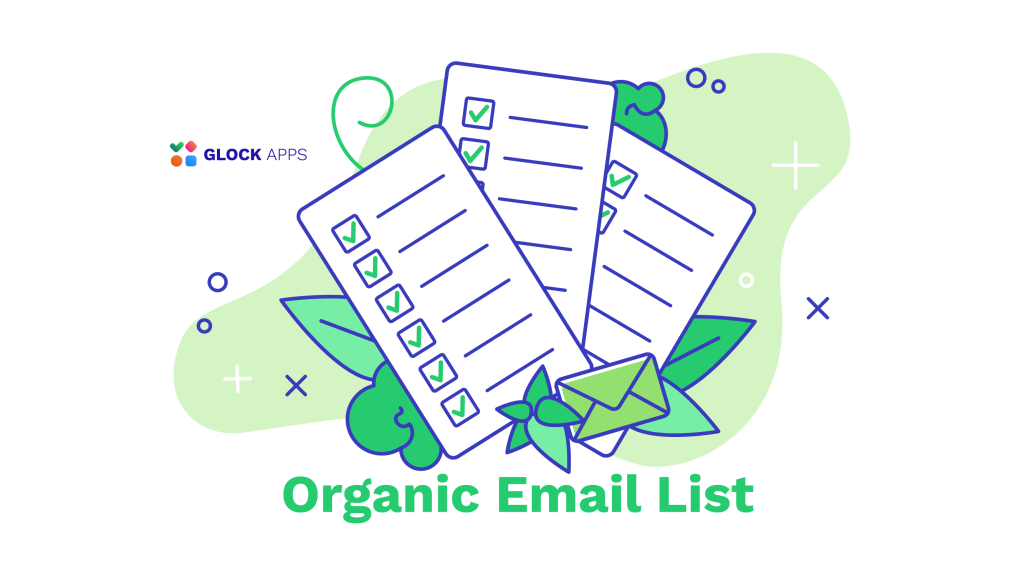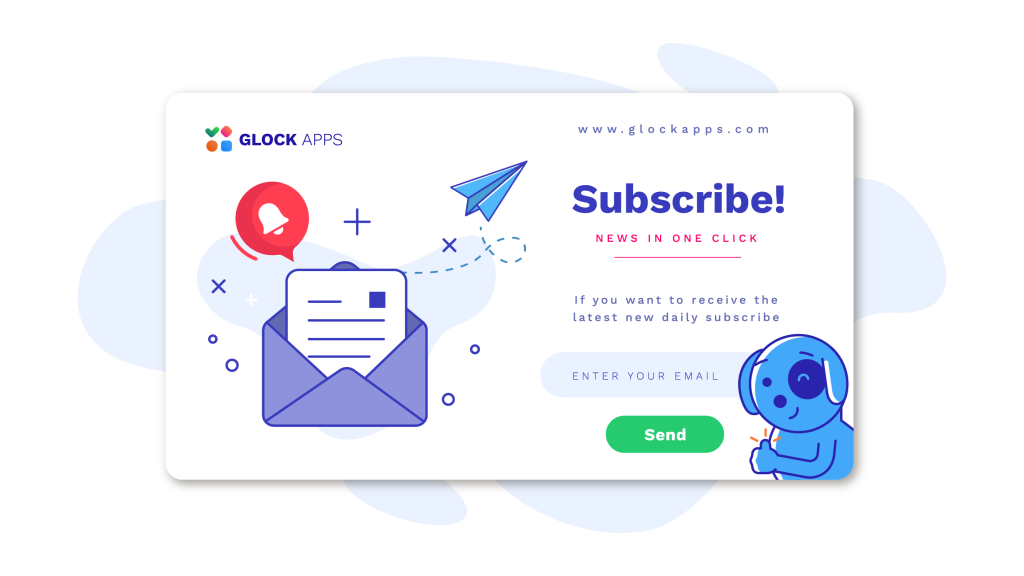Part I: Email List Building
Table of contents
- Email List Building Fundamentals
- How to Begin Building an Email List
- Reasons to Start Building Your Email List Organically
- 1. Organic Email List Gives Better Deliverability.
- 2. Organic Email List Gives Better Open and Conversion Rates.
- 3. Organic Email List Allows to Measure True Success or Failure of Email Campaign.
- 4. Organic Email List Protects Sender Reputation.
- 5. Organic Email List Protects You at the Legislative Level.
- Best Practices for Building Your Email List Organically
- Frequently Asked Questions
Email List Building Fundamentals
Before you can send out an email campaign, you need to get an email list. You need an audience to receive your messages.
List building is a process of collecting email addresses of the recipients who want to receive your emails.
How to Begin Building an Email List
When you think about building your first mailing list, you’ll want to avoid the following bad practices:
- do not buy an email list;
- do not rent an email list from third parties;
- do not harvest email addresses on the Internet.

It will initially appear as if you’ve gained a substantial amount of email subscribers. However, the consequences may be detrimental for your reputation. The reasons for not using any of these list building methods are:
1. Law violation.
These people did not explicitly opt-in to your emails or give you permission to send them marketing emails. Thus, you’ll be violating the law (CAN-SPAM Act in the US and GDPR in Europe, in particular) by sending unsolicited emails to those people.
2. Poor engagement.
Scraped and purchased email lists are likely to generate a lot of negative actions. If an email address is publicly published, it’s already been scraped by a lot of people and sent tons of spam. If a live person is still using that email address, they’re probably tired of spammers and will report your message as spam or delete it without opening it. It has a negative impact on your sender reputation and future deliverability.
3. Spam traps.
When you purchase, rent or scrub email addresses, you don’t know if they belong to real recipients or not. Spam trap emails work as normal mailboxes, but every spam trap hit is tracked by an anti-spam organization or Internet service provider. Senders emailing to spam trap addresses are penalized by having their IP or domains blacklisted and their accounts with email service providers suspended.
4. Bad sender reputation.
Many of the scraped or purchased lists contain fake or disposable email addresses that people use simply to sign up and receive some free content or participate in a giveaway. They’re not looking for receiving emails after they sign up. Thus, email messages sent to purchased or harvested email lists will produce high unsubscribe, user complaint, and bounce rates.
In total, these will ultimately negatively impact your sender reputation and email deliverability without the guarantee of new customers.
5. Low deliverability.
Internet service providers make email placement decisions based on various factors where the most important one is sender reputation. As mentioned above, your sender reputation is determined by the quality of the emails on your mailing list. The more emails you send to invalid, inactive, fake or spam trap addresses, the worse your sender reputation score will be and the more emails will be filtered out to Spam or blocked at a gateway.
Moreover, big email service providers that care about their reputation and strive to guarantee high deliverability to all their users won’t even allow you to upload your email list if you don’t prove that it is an opt-in list.
Reasons to Start Building Your Email List Organically
Working for more than 20 years in the email marketing industry, one of the most important lessons we have learned is that an organically built email list is the key prerequisite for high deliverability. Quality will always be more important than quantity in email marketing.

So, if you want to send effective email marketing campaigns, then be patient and build your list organically.
There are at least five reasons for doing this:
1. Organic Email List Gives Better Deliverability.
If you send to a list of people who subscribed to receiving your email communications, the chances for the email addresses to be valid are higher. Thus, the chances for your emails to reach the recipients are higher. Plus, oftentimes, the recipients add the email addresses of trusted senders and the senders they expect emails from to their whitelists. This guarantees the Inbox placement for your emails.
2. Organic Email List Gives Better Open and Conversion Rates.
It is evident, but some marketers overlook it. In addition to better deliverability when emails are actually reaching the target recipients, organic lists give you better open rates.
An organic list is a much more engaged list. That is because organic lists give you the audience that wants to see what you have to offer and the likelihood that the email will be opened, read and acted on is higher.
With a scraped or bought list, you’re sending emails to people who have not had any previous interaction with your brand and don’t have a clue who you are and why you are sending emails to them. Why would they want to read your email then?
3. Organic Email List Allows to Measure True Success or Failure of Email Campaign.
Imagine that you purchased an email list and the selling company said that the recipients are your target audience. You prepared a great offer that is likely to convert, you created a beautiful email newsletter and sent it to the purchased list.
If your open rate is very low and conversion rate is zero, can you really know whether your email copy was not good or your offer was not attractive enough? No.
Your email newsletter and offer may be the best ones ever and might attract a lot of recipients, “targeted recipients.” But if only 0,01% of the recipients on your purchased list opened your email and none of them took your offer, then you will think that your email copy and offer are not effective.
Now, let’s say you have an organic list that you collected on your own through a subscription form on your website or landing page. You use the same email newsletter and same offer and send it out.
This time, you can measure true conversion and determine the problem if your campaign fails. If your open rate is low, the issue is likely in the Subject that was not teasing enough. If the open rate is good but conversions are low, it turns out that your offer was not relevant or not seducing. After all, people reading your email are ready to act.
4. Organic Email List Protects Sender Reputation.
One of the essential factors that builds your reputation as a sender is subscriber engagement. Mailbox providers monitor how their users treat email messages – whether they are opening or deleting emails, moving emails to the spam folder or from spam to Inbox, reporting a spam complaint or replying to the sender. All the user’s actions are evaluated and used to calculate the sender reputation, based on which the ISP will apply a filtering algorithm to future messages coming from the sender.
With a quality email list, you increase the chances of building and maintaining a high reputation of your sending domain and IP address in times, which, in turn, will lead to an increased Inbox placement rate for your emails.
5. Organic Email List Protects You at the Legislative Level.
In many countries, senders must have permission from the recipients to send marketing and commercial emails to them. Moreover, a confirmed opt-in method must be used to collect subscribers. The email marketing rules of some countries don’t allow the use of pre-checked boxes on the subscription form to make sure a recipient gives the permission thoughtfully. When you have a record of a user subscription, you protect yourself at the legislative level and eliminate negative consequences if someone still files a complaint.
Obviously, organic email list building certainly takes more time and effort than scraping or purchasing a list. But in the long run, it will be paid off. After all, a 0,1% open rate with a purchased list gives you fewer conversions than an organically built list with 50% open rate.
Want to discover more? Check out our full PDF guide “Effective Email List Building and Management” for free!
Best Practices for Building Your Email List Organically
So, what’s the best way to build an email list? The answer is a subscription form on your website that asks for the email address. You may have other fields on the form if you want to personalize your future email campaigns and send more targeted messages, but the email address is the minimum information you have to ask for.
You’ll want to follow these recommendations when working on your subscription process to build a quality and responsive email list:
1. Choose a Subscription Form Type.
Your recipient should knowingly subscribe to receive your emails. There are various methods to create a subscription form. You could use a form embedded on the sidebar or in the footer of the website or a pop-up form appearing when a user leaves the page. A floating form may be affixed to any area of the page. It would stay there until the reader takes an action or closes it. It is also possible to combine different types of subscription forms to attract as many email recipients as possible.

2. Set up Confirmed Opt-In Method.
There is a debate about what is better: a single opt-in or a confirmed opt-in method. A single opt-in process allows you to build a bigger list faster. However, as it was mentioned, quality always beats quantity in email marketing. Thus, it’s highly recommended to set up a confirmed opt-in process because:
- it eliminates invalid addresses resulting from typos;
- it excludes malicious and erroneous subscriptions;
- It ensures the recipient consciously gives you their email address.
Obviously, a confirmed opt-in method requires an additional action from the subscriber, but people who are truly interested in what you have to offer will not mind taking that extra step and confirming their subscription.
3. Use Lead Magnet.

People are more willing to subscribe if they can receive something in return for their email addresses. For instance, you might provide a special subscriber-only discount or access to exclusive materials like research, ebook, tutorials, webinars etc. You can even indicate a condition for the validity of the offer like it will be available for the first 100 subscribers or it will be valid for those who subscribed during this week. This kind of thinking will motivate your prospective recipients to sign up.
4. Avoid Pre-Checked Opt-In Boxes.
In the Netherlands, pre-checked boxes are not allowed as a mode of consent. In other countries, it may be legal, but we still do not recommend that you automatically send marketing emails to people if they’re not formally opted-in.
Also, companies often use a passive opt-in process when a user must check an empty box if they don’t want to subscribe to mailings. People often fill the form on auto-pilot and get subscribed without giving an explicit consent. In the future, such a passive opt-in process can result in a high complaint rate.
5. Allow Subscribers to Set Preferences.
If you plan to send different types of email communications such as product updates, blog news, marketing and promotional messages, consider allowing a subscriber to choose what they want to receive from you.
It is also a good idea to ask the subscriber how often they would prefer receiving emails. You could then build several email lists based on the email type and frequency. The more targeted emails you send, the better engagement and conversions will be.
6. Send Welcome Email to New Subscribers.
The welcome message helps confirm and activate the new relationship. It’s the start of your dialogue with the recipient, which will then be continued by your regular email communications. Also, the first email can help you determine deliverability problems before they affect your Inbox placement rate and sender reputation. You can test your welcome email on auto-pilot on a regular basis with the GlockApps Inbox Insight tests to see if it’s still hitting the Inbox.
7. Remove Distribution and Role Email Addresses.
Certain email addresses are set up to have a specific function within an organization and are intended only to receive messages related to that function. For example, “support@domain.com” is the email address a company uses to receive support requests from their clients.
Because such accounts are tied to specific functions in a company, they’re not intended for personal use such as subscribing to email marketing communications. However, some people may still use such role email addresses in order to subscribe and receive some offer they consider valuable. But most likely they won’t be interested in receiving further communications from the company.
To avoid submissions with role email addresses, you may use a checker that would verify the entered email address and not allow submit the request if the use of a role address is detected.
If it seems too complicated, you could do verification manually. Before you send your first email campaign, you’ll want to review your list, spot distribution and role email addresses, and remove them from the list.
To recap:
Your mailing list determines the success or failure of your email campaigns. Purchased or harvested email lists will bring you a lot of trouble and will have a detrimental impact on your sender reputation. To maximize your email marketing efforts, focus on building your email list organically by collecting email subscribers through an opt-in form. Starting with an organic list building involves three main steps:
- Create a beautiful subscription form.
- Decide on a good teaser.
- Configure the subscription process with a welcome message.
When you come up with your first thousand subscribers and start sending email communications to them, you’ll be able to measure your open rates to understand if you are doing it right. And then you can think about growing your email list by attracting more and more subscribers.
Frequently Asked Questions
What is email list building?
The process of gathering email addresses is referred to as “email list building.” This enables you to build your contact database and use email to communicate with your subscribers.
Why is building an email list important?
Email communications allow you to build relationships with your client base and grow your sales by sending them your offers and proposals. As the law dictates that you cannot send without permission, you need to get the client’s explicit permission to send your messages to them. If they bought something from you or downloaded a free trial or created a free account with your service, it doesn’t mean you can send your marketing email campaigns to those people. They must opt-in to receive your emails before you can start sending.
How should I begin building an email list?
The simplest way is to create a landing page with an opt-in form and include the link to it in your welcome message that is sent when a user creates a free account or downloads a free trial. If you have a blog where you publish articles, you may include an opt-in form in blog posts or add pop-up opt-in forms that appear when a user is reading a post. You can also use social media channels to send people to your landing page.
Why should you start building your email list?
Building your own email list is important because this will allow you to create a database of email subscribers interested in what you have to offer. A good user engagement will lead to a higher Inbox placement rate, open rate, and conversion rate.
You’ve explored the first part of our comprehensive email marketing guide. Stay tuned for more valuable information in the upcoming sections!
The second part of this guide is waiting for you here.



